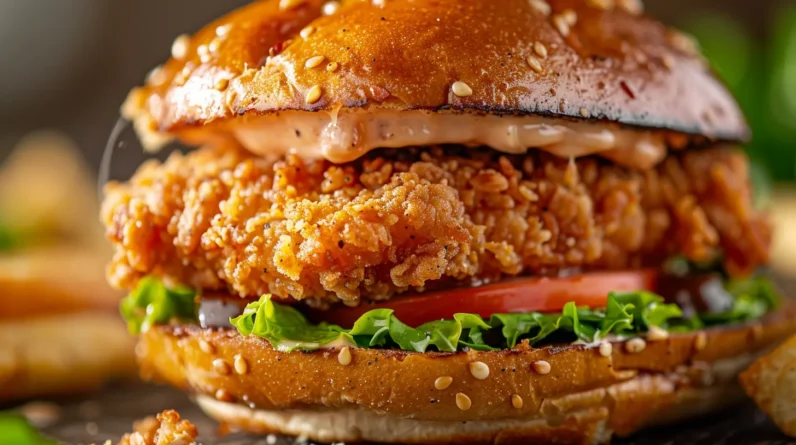
We’ll help you create safe and delicious chicken burgers that everyone can enjoy, regardless of common food allergies. By using ground chicken breast as our base, we avoid the top eight allergens while maintaining great flavor and protein content. We’ll substitute traditional binding agents with chia seeds and replace wheat breadcrumbs with gluten-free oats. Proper kitchen protocols, like using separate cutting boards and thorough cleaning, prevent cross-contamination. From fresh herbs for seasoning to lettuce wraps instead of buns, we’ve got options for customization. Let’s explore how to make these allergen-friendly burgers that don’t compromise on taste or texture.
Understanding Common Food Allergies
Eight common food allergens account for about 90% of all food allergic reactions in the United States: milk, eggs, fish, shellfish, tree nuts, peanuts, wheat, and soy. When we create allergy-friendly recipes, we must carefully consider cross-contamination risks and ingredient substitutions that maintain both safety and flavor.
We’ll need to understand how these allergens often hide in common ingredients. For example, wheat isn’t just in obvious sources like bread crumbs; it can appear as modified food starch or natural flavoring. Eggs, commonly used as binders in traditional burgers, may be listed as albumen or lecithin. Soy can be present in vegetable oils or emulsifiers. By identifying these hidden sources and understanding proper substitution ratios, we can develop chicken burger recipes that are both safe and delicious for those with food allergies.
Essential Kitchen Safety Tips
Beyond understanding allergens, maintaining a safe kitchen environment forms the foundation for preparing allergy-friendly meals. We’ll need separate cutting boards, utensils, and preparation areas to prevent cross-contamination between allergen-containing and allergen-free foods. Let’s thoroughly sanitize all surfaces before and after food preparation, using hot, soapy water or appropriate cleaning solutions.
We must store allergen-free ingredients in sealed, clearly labeled containers on separate shelves above common allergens. It’s critical to wash our hands thoroughly between handling different ingredients and wear clean gloves when necessary. We’ll also establish a system for checking ingredient labels each time we cook, as manufacturers can change formulations without notice. Let’s keep our allergy emergency protocol visible and ensure all kitchen staff knows how to recognize and respond to allergic reactions.
Basic Ingredients and Substitutions
For our allergy-friendly chicken burgers, we’ll need carefully selected ingredients that avoid common allergens while maintaining flavor and texture. We’ll use ground chicken breast as our protein base, which is naturally free from common allergens. Instead of wheat-based breadcrumbs, we’ll incorporate gluten-free oats or quinoa flakes as our binder.
To replace egg, we’ll use ground chia seeds mixed with water, providing both binding properties and omega-3 fatty acids. For seasoning, we’ll combine salt, garlic powder, and fresh herbs, avoiding pre-mixed seasonings that might contain hidden allergens. If you’re sensitive to nightshades, substitute black pepper and ginger for paprika. We can serve these burgers on lettuce wraps or gluten-free buns, topped with avocado instead of traditional dairy-based condiments.
Building Your Perfect Burger
Creating a well-structured chicken burger starts with proper layering and assembly techniques. We’ll begin with a lightly toasted allergen-free bun, applying a thin layer of dairy-free spread to prevent sogginess. Next, we’ll place fresh lettuce leaves as a moisture barrier, followed by our seasoned chicken patty while it’s still hot.
For optimal texture and nutritional balance, we’ll layer sliced tomatoes, cucumber, and red onions on top of the patty. If you’re using allergen-free cheese alternatives, place them directly on the hot patty to encourage melting. We’ll finish with microgreens or sprouts for added nutrients and texture. Remember to secure all components with a bamboo skewer, cutting the burger diagonally to ensure ingredients stay in place while maintaining structural integrity.
Serving and Storage Guidelines
Once you’ve assembled your chicken burger, proper serving and storage practices will maintain its quality and safety. Serve immediately while the internal temperature remains at 165°F (74°C), and don’t let cooked patties sit at room temperature for more than two hours.
For storage, we recommend cooling burgers completely before refrigerating in airtight containers. They’ll keep for up to three days when properly refrigerated at 40°F (4°C) or below. If freezing, wrap individual patties in parchment paper, then seal in freezer-safe bags with air removed. They’ll maintain optimal quality for up to four months frozen.
When reheating, bring refrigerated patties to 165°F (74°C) throughout. For frozen patties, thaw overnight in the refrigerator before reheating to ensure even temperature distribution and food safety.
Conclusion
We’ve explored how to make chicken burgers that are safe havens for those with food allergies while keeping flavor front and center. Like pieces of a puzzle, we’ve put together the essential elements: allergen awareness, kitchen safety, smart substitutions, and proper handling. By following these nutrition-focused guidelines, we can create delicious, wholesome burgers that everyone at the table can enjoy with confidence.







